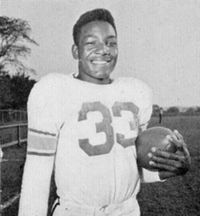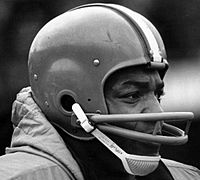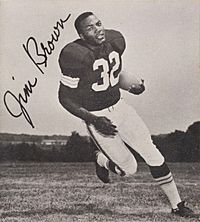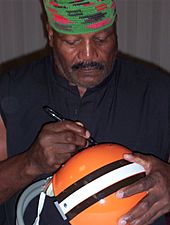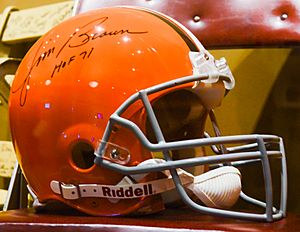Jim Brown facts for kids

Brown with the Cleveland Browns in 1959
|
|||||||||||||||
| No. 32 | |||||||||||||||
|---|---|---|---|---|---|---|---|---|---|---|---|---|---|---|---|
| Position: | Fullback | ||||||||||||||
| Personal information | |||||||||||||||
| Born: | February 17, 1936 St. Simons Island, Georgia, U.S. |
||||||||||||||
| Died: | May 18, 2023 (aged 87) Los Angeles, California, U.S. |
||||||||||||||
| Height: | 6 ft 2 in (1.88 m) | ||||||||||||||
| Weight: | 232 lb (105 kg) | ||||||||||||||
| Career information | |||||||||||||||
| High school: | Manhasset (Manhasset, New York) | ||||||||||||||
| College: | Syracuse (1954–1956) | ||||||||||||||
| NFL Draft: | 1957 / Round: 1 / Pick: 6 | ||||||||||||||
| Career history | |||||||||||||||
|
|||||||||||||||
| Career highlights and awards | |||||||||||||||
|
|||||||||||||||
| Career NFL statistics | |||||||||||||||
|
|||||||||||||||
| Player stats at PFR | |||||||||||||||
|
Pro Football Hall of Fame
|
|||||||||||||||
|
College Football Hall of Fame
|
|||||||||||||||
James Nathaniel Brown (February 17, 1936 – May 18, 2023) was an American football fullback, civil rights activist, and actor. He played for the Cleveland Browns of the National Football League (NFL) from 1957 through 1965. Considered to be one of the greatest running backs of all time, as well as one of the greatest players in NFL history, Brown was a Pro Bowl invitee every season he was in the league, was recognized as the AP NFL Most Valuable Player three times, and won an NFL championship with the Browns in 1964. He led the league in rushing yards in eight out of his nine seasons, and by the time he retired, he held most major rushing records. In 2002, he was named by The Sporting News as the greatest professional football player ever.
Brown earned unanimous All-America honors playing college football at Syracuse University, where he was an all-around player for the Syracuse Orangemen football team. The team later retired his number 44 jersey, and he was inducted into the College Football Hall of Fame in 1995. He is also widely considered one of the greatest lacrosse players of all time, and the Premier Lacrosse League MVP Award is named in his honor. Brown also excelled in basketball and track and field.
In his professional career, Brown carried the ball 2,359 times for 12,312 rushing yards and 106 touchdowns, which were all records when he retired. He averaged 104.3 rushing yards per game, and is the only player in NFL history to average over 100 rushing yards per game for his career. Brown was enshrined in the Pro Football Hall of Fame in 1971. He was named to the NFL's 50th, 75th, and 100th Anniversary All-Time Teams, comprising the best players in NFL history. Brown was honored at the 2020 College Football Playoff National Championship as the greatest college football player of all time. His number 32 jersey is retired by the Browns.
Shortly before the end of his football career, Brown became an actor. He retired at the peak of his football career to pursue an acting career. He obtained 53 acting credits and several leading roles throughout the 1970s. He has been described as Hollywood's first black action hero and his role in the 1969 film 100 Rifles made cinematic history for featuring interracial love scenes.
Brown was one of the few athletes, and among the most prominent African Americans, to speak out on racial issues as the civil rights movement was growing in the 1950s. He participated in the Cleveland Summit after Muhammad Ali faced imprisonment for refusing to enter the draft for the Vietnam War, and he founded the Black Economic Union to help promote economic opportunities for minority-owned businesses. Brown later launched a foundation focused on diverting at-risk youth from violence through teaching them life skills, through which he facilitated the Watts truce between rival street gangs in Los Angeles.
Contents
Early life
Brown was born in St. Simons Island, Georgia, to Swinton Brown, a professional boxer, and his wife, Theresa, a homemaker. He attended Manhasset Secondary School in Manhasset, New York. Brown earned 13 letters playing football, lacrosse, baseball, basketball, and running track.
Mr. Brown credits his self-reliance to having grown up on Saint Simons Island, a community off the coast of Georgia where he was raised by his grandmother and where racism did not affect him directly. At the age of eight, he moved to Manhasset, New York, on Long Island, where his mother worked as a domestic. It was at Manhasset High School that he became a football star and athletic legend.
Brown averaged a then-Long Island record 38 points per game for his basketball team. That record was later broken by future Boston Red Sox star Carl Yastrzemski of Bridgehampton.
College career
Lawyer and Syracuse University lacrosse star Kenneth Molloy, who was involved with the lacrosse program at Manhasset, was a benefactor of Brown and persuaded his alma mater to admit him, which was difficult because according to Molloy, "[Syracuse] did not want black athletes." Brown was the only African-American player on the football team as a freshman in 1953, and promises of a full scholarship in the second half of the year were not honored; Molloy personally financed and fundraised for Brown's first year at the school. He endured racist taunts while he was at Syracuse. He was treated differently from teammates: he was housed in a non-athlete dormitory, warned against dating Caucasian women, and the coaching staff attempted to put him at other positions, including punter, lineman, and wide receiver.
As a sophomore at Syracuse, Brown was the second-leading rusher on the team. As a junior, he rushed for 676 yards (5.2 per carry). In his senior year in 1956, Brown was a consensus first-team All-American. He finished fifth in the Heisman Trophy voting and set school records for highest season rush average (6.2) and most rushing touchdowns in a single game (6). He ran for 986 yards—third-most in the country despite Syracuse playing only eight games—and scored 14 touchdowns. In the regular-season finale, a 61–7 rout of Colgate, he rushed for 197 yards, scored six touchdowns, and kicked seven extra points for a school-record 43 points. Then in the Cotton Bowl, he rushed for 132 yards, scored three touchdowns, and kicked three extra points, but a blocked extra point after Syracuse's third touchdown was the difference as TCU won 28–27.
In addition to his football accomplishments, he excelled in basketball, track, and especially lacrosse. As a sophomore, he was the second-leading scorer for the basketball team (15 ppg), and earned a letter on the track team. In 1955, he finished in fifth place in the National Championship decathlon. His junior year, he averaged 11.3 points in basketball, and was named a second-team All-American in lacrosse. His senior year, he was named a first-team All-American in lacrosse (43 goals in 10 games to rank second in scoring nationally). Brown was so dominant in the game, that lacrosse rules were changed requiring a lacrosse player to keep their stick in constant motion when carrying the ball (instead of holding it close to his body). There is currently no rule in lacrosse that requires a player to keep their stick in motion. He is in the Lacrosse Hall of Fame. The JMA Wireless Dome has an 800 square-foot tapestry depicting Brown in football and lacrosse uniforms with the words "Greatest Player Ever".
While in college, Brown participated in the Reserve Officers' Training Corps. After graduating he was commissioned as a second lieutenant. During his time in the NFL, Brown continued his military commitment as a member of the United States Army Reserve. He served for four years and was discharged with the rank of captain.
Professional career

Brown was taken in the first round of the 1957 NFL draft by the Cleveland Browns, the sixth overall selection. In the ninth game of his rookie season, against the Los Angeles Rams he rushed for 237 yards, setting an NFL single-game record that stood unsurpassed for 14 years and a rookie record that remained for 40 years.
Brown broke the single-season rushing record in 1958, gaining 1,527 yards in the 12-game season, shattering the previous NFL mark of 1,146 yards set by Steve Van Buren in 1949. In this MVP season, Brown led all players with a staggering 17 touchdowns scored, beating his nearest rival, Baltimore Colts wide receiver Raymond Berry, by 8.
After nine years in the NFL, he departed as the league's record holder for both single-season (1,863 in 1963) and career rushing (12,312 yards), as well as the all-time leader in rushing touchdowns (106), total touchdowns (126), and all-purpose yards (15,549). He was the first player to reach the 100-rushing-touchdowns milestone, and only a few others have done so since, despite the league's expansion to a 16-game season in 1978 (Brown's first four seasons were only 12 games, and his last five were 14 games).
Brown's record of scoring 100 touchdowns in only 93 games stood until LaDainian Tomlinson did it in 89 games during the 2006 season. Brown holds the record for total seasons leading the NFL in all-purpose yards (five: 1958–1961, 1964), and is the only rusher in NFL history to average over 100 yards per game for a career. In addition to his rushing, Brown was a superb receiver out of the backfield, catching 262 passes for 2,499 yards and 20 touchdowns, while also adding another 628 yards returning kickoffs. In every season he played, Brown was voted into the Pro Bowl, and he left the league in style by scoring three touchdowns in his final Pro Bowl game.
He told me, "Make sure when anyone tackles you he remembers how much it hurts." He lived by that philosophy and I always followed that advice.
Brown's 1,863 rushing yards in the 1963 season remains a Cleveland franchise record. It is currently the oldest franchise record for rushing yards out of all 32 NFL teams. His average of 133 yards per game that season is exceeded only by O. J. Simpson's 1973 season. Brown led the league in rushing a record eight times. He was also the first NFL player to rush for over 10,000 yards. He was very difficult to tackle (shown by his all-time record of 5.2 yards per carry), often requiring more than one defender to bring him down. Brown was famous for his stiff arm and combined speed, power and relentless endurance as a rusher.
After winning his third league MVP award in 1965, Brown retired in July 1966 at age 30 while still in top form. He was in England for the shooting of the movie The Dirty Dozen. He had expected to return to the Browns afterwards, but retired when team owner Art Modell threatened him with fines for missing training camp. Brown held the NFL career rushing record of 12,312 yards until it was broken by Walter Payton on October 7, 1984, during Payton's 10th NFL season. Brown is still the Browns' all-time leading rusher. As of 2018, he ranked 11th on the all-time rushing list.
During Brown's career, Cleveland won the NFL championship in 1964 and were runners-up in 1957 and 1965, his rookie and final season, respectively. In the 1964 championship game, Brown rushed 27 times for 114 yards and caught 3 passes for 37.
Acting career
Brown appeared in many movies and was at times described as a black Superman or a black John Wayne. While not considered a gifted actor, he helped to expand the range of roles available to black actors.
Early films
Brown began his acting career before the 1964 season, playing a buffalo soldier in a Western action film called Rio Conchos. The film premiered at Cleveland's Hippodrome theater on October 23, with Brown and many of his teammates in attendance. The reaction was lukewarm. Brown, one reviewer said, was a serviceable actor, but the movie's overcooked plotting and implausibility amounted to "a vigorous melodrama for the unsqueamish."
In early 1966, Brown was shooting his second film in London. MGM's The Dirty Dozen cast Brown as Robert Jefferson, one of 12 convicts sent to France during World War II to assassinate German officers meeting at a castle near Rennes in Brittany before the D-Day invasion. Production delays due to bad weather meant he missed at least the first part of training camp on the campus of Hiram College, which annoyed Cleveland Browns owner Art Modell, who threatened to fine Brown $1,500 (equivalent to $13,500 in 2022) for every week of camp he missed. Brown, who had previously said that 1966 would be his last season, the final year of a three-year contract, announced his retirement, instead.
Leading man

MGM cast Brown in his first lead role in The Split (1968), based on a Parker novel by Donald E. Westlake. He was paid $125,000 for the role.
Brown followed it with Riot (1969), a prison film for MGM. Both it and The Split were solid hits at the box office. Biographer Mike Freeman credits Brown with becoming "the first black action star", due to roles such as the Marine captain he portrayed in the hit 1968 film Ice Station Zebra.
Brown went to 20th Century Fox for 100 Rifles (1969). Brown was billed over co stars Raquel Welch and Burt Reynolds and had a love scene with Welch, one of the first interracial love scenes and the first in a major Hollywood movie. Raquel Welch reflected on the scene in Spike Lee's Jim Brown: All-American. For this role, Brown was paid $200,000 and received five percent of the film's box office, becoming one of the highest paid black actors.
Later acting career
His 1980s appearances were mostly on television. Brown appeared in some TV shows including Knight Rider in the season-three premiere episode "Knight of the Drones". Brown appeared alongside fellow former football player Joe Namath on The A-Team episode "Quarterback Sneak". Brown also appeared on CHiPs, episodes one and two, in season three, as a pickpocket on roller skates.
He appeared opposite Arnold Schwarzenegger in 1987's The Running Man, an adaptation of a Stephen King novel, as Fireball, and had a cameo in the spoof I'm Gonna Git You Sucka (1988).
Brown appeared in Mars Attacks! (1996) and Sucker Free City (2004) and played a defensive coach, Montezuma Monroe, in Any Given Sunday (1999).
Civil rights work
Brown was one of the few athletes to speak out on racial issues in the 1950s as the civil rights movement was growing. He was one of the most prominent African American athletes to engage in civil rights activism, and he called on other African American athletes to become involved in similar initiatives off the field. In 1967, Brown, alongside Bill Russell, Kareem Abdul-Jabbar, and Carl Stokes, were all members of the Cleveland Summit, a meeting with Muhammad Ali held with the intention of convincing the four to rally behind and recruit others to help Ali's cause of civil rights in the United States. Because Ali was a "pariah" in American society at the time because of his opposition to the Vietnam War and refusal to enter the draft, his boxing license had been revoked, and he faced up to five years in prison. For Brown and the other participants to stand with Ali in support of him and his position consequently put "their reputations and their careers" at risk. The Cleveland Summit was later called "a significant turning point for the role of the athlete in society" and "one of the most important civil rights acts in sports history", as well as a predecessor of the 21st century protest movement initiated by Colin Kaepernick.
In 1966, Brown founded the Negro Industrial Economic Union, later known as the Black Economic Union (BEU), to help promote economic opportunities for minority owned businesses. Brown later stated in a 1968 Ebony interview, "We've got to stop wasting all our energy and money marching and picketing and going things like camping-down in Washington on a Poor People's Campaign...We've got to get off the emotional stuff and do something that will bring about real change. We've got to have industries and commercial enterprises and build our own sustaining economic base. Then we can face white folks man-to-man and we can deal." The BEU secured loans and grants, including from the Ford Foundation, to support community initiatives related to food, medicines and farm and economic ventures in specific counties, starting with Marshall County, Mississippi. Because of Brown's economic advocacy for the African American community, Richard Nixon expressed support for black capitalism in his campaign in the 1968 United States presidential election and received an endorsement from Brown. In 1988, Brown founded the Amer-I-Can Foundation, an organization that sought to divert gang members and prisoners from violence by teaching them life skills. Through the foundation, Brown helped establish the Watts truce between rival street gangs in Los Angeles.
Perceiving Brown and other outspoken African-American athletes as a threat, the Federal Bureau of Investigation monitored Brown and his organizations. Files declassified in 2003 showed that the FBI, the United States Secret Service, and several police departments had monitored Brown and the Black Economic Union, attempting to smear the group as a source of Communist and radical Muslim extremism and collecting information to damage Brown's reputation.
Other post-football activities
Brown also worked as a color analyst on NFL telecasts for CBS in 1978, teaming with Vin Scully and George Allen.
In 1983, 17 years after retiring from professional football, Brown mused about coming out of retirement to play for the Los Angeles Raiders when it appeared that Pittsburgh Steelers running back Franco Harris would break Brown's all-time rushing record. Brown disliked Harris' style of running, criticizing the Steelers' running back's tendency to run out of bounds, a marked contrast to Brown's approach of fighting for every yard and taking on the approaching tackler. Eventually, Walter Payton of the Chicago Bears broke the record on October 7, 1984, with Brown having ended thoughts of a comeback. Harris, who retired after the 1984 season after playing eight games with the Seattle Seahawks, fell short of Brown's mark. Following Harris's last season, in that January, a challenge between Brown and Harris in a 40-yard dash was nationally televised. Brown, at 48 years old, was certain he could beat Harris, though Harris was only 34 years old and just ending his elite career. Harris clocked in at 5.16 seconds, and Brown in at 5.72 seconds, pulling up in towards the end of the race clutching his hamstring.
In 1965, Brown was the first black televised boxing announcer when he announced a televised boxing match in the United States, for the Terrell–Chuvalo fight, and is also credited with then first suggesting a career in boxing promotion to Bob Arum.
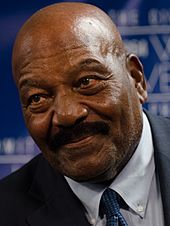
Brown's autobiography, published in 1989 by Zebra Books, was titled Out of Bounds and was co-written with Steve Delsohn. He was a subject of the book Jim: The Author's Self-Centered Memoir of the Great Jim Brown, by James Toback.
In 1993, Brown was hired as a color commentator for the Ultimate Fighting Championship, a role he occupied for the first six pay-per-view events. In 2008, Brown initiated a lawsuit against Sony and EA Sports for using his likeness in the Madden NFL video game series. He claimed that he "never signed away any rights that would allow his likeness to be used". From 2008 until his death, Brown served as an executive advisor to the Browns. In that capacity he helped to build relationships with the team's players and to further enhance the NFL's wide range of sponsored programs through the team's player programs department. On May 29, 2013, Brown was named a special advisor to the Browns. Brown became a part-owner of the New York Lizards of Major League Lacrosse, joining a group of investors in the purchase of the team in 2012.
On October 11, 2018, Brown along with Kanye West met with President Donald Trump to discuss the state of America, among other topics. Criticized by the black community for the meeting, Brown said that Trump was the sitting president and "we can't ignore that seat and just call names of the person that's sitting in it". Brown called him "accessible", and said that the president was not a racist.
Personal life
Brown married his first wife Sue Brown (née Jones) in September 1959. She sued for divorce in 1968, charging him with "gross neglect". Together, they had three children, twins born 1960, and a son born 1962. Their divorce was finalized in 1972. Brown was ordered to pay $2,500 per month in alimony and $100 per week for child support.
In December 1973, Brown proposed to 18-year-old Diane Stanley, a Clark College student he met in Acapulco, Mexico, in April of that year. They broke off their engagement in 1974. Brown married his second wife, Monique, in 1997; they had two children.
Death
Brown died of natural causes, at the age of 87 on May 18, 2023, at his home in Los Angeles. He died with his wife by his side. Tributes from the sports world and beyond soon poured in, with former NFL running back Barry Sanders posting on Twitter that "You can't underestimate the impact Jim Brown had on the NFL." Emmitt Smith, the NFL's all-time leader in rushing yards, wrote "He is and was a true legend in sports and in the community using his platform to help others." NFL Commissioner Roger Goodell said "Jim Brown was a gifted athlete — one of the most dominant players to ever step on any athletic field — but also a cultural figure who helped promote change." LeBron James, an NBA star, wrote in tribute that "We lost a hero today. Rest in Paradise to the legend Jim Brown. I hope every Black athlete takes the time to educate themselves about this incredible man and what he did to change all of our lives. We all stand on your shoulders Jim Brown." Barack Obama, the 44th president and the first Black president of the United States, wrote, "I was too young to remember Jim Brown's playing days, but I knew his legacy. One of the greatest football players ever, he was also an actor and activist – speaking out on civil rights, and pushing other black athletes to do the same."
Sporting accolades
Brown's memorable professional career led to his induction into the Pro Football Hall of Fame in 1971. His football accomplishments at Syracuse garnered him a berth in the College Football Hall of Fame in 1995. Brown was inducted in the National Lacrosse Hall of Fame in 1983.
Brown is the only NFL player to average 100 rushing yards per game for their career. In 118 career games, he averaged 104.3 yards per game and 5.2 yards per carry; only Barry Sanders (99.8 yards per game and 5.0 yards per carry) comes close to these totals. For example, Hall of Famer Walter Payton averaged only 88 yards per game during his career with a 4.4 yards-per-carry average. Emmitt Smith averaged only 81.2 yards per game with a 4.2 yards-per-carry average. Brown held the yards-per-carry record by a running back (minimum 750 carries) from his retirement in 1965 until Jamaal Charles broke the record in 2012.
ESPN's SportsCentury in 1999 ranked Brown fourth among their 50 Greatest Atheletes of the 20th Century, trailing only Muhammed Ali, Babe Ruth, and Michael Jordan. In 2002, The Sporting News selected him as the greatest football player of all time, as did the New York Daily News in 2014. On November 4, 2010, Brown was chosen by NFL Network's NFL Films production The Top 100: NFL's Greatest Players as the second-greatest player in NFL history, behind only Jerry Rice. In November 2019, he was selected as one of the twelve running backs on the NFL 100th Anniversary All-Time Team.
On January 13, 2020, Brown was named the greatest college football player of all time by ESPN, during a ceremony at the College Football Playoff National Championship Game celebrating the 150th anniversary of college football.
NFL career statistics
| Legend | |
|---|---|
| AP NFL MVP | |
| Won the NFL championship | |
| NFL record | |
| Led the league | |
| Bold | Career high |
Regular season
| Year | Team | Games | Rushing | Receiving | Fum | |||||||||||
|---|---|---|---|---|---|---|---|---|---|---|---|---|---|---|---|---|
| GP | GS | Att | Yds | Y/A | Y/G | A/G | Lng | TD | Rec | Yds | Y/R | Lng | TD | |||
| 1957 | CLE | 12 | 12 | 202 | 942 | 4.7 | 78.5 | 16.8 | 69 | 9 | 16 | 55 | 3.4 | 12 | 1 | 7 |
| 1958 | CLE | 12 | 12 | 257 | 1,527 | 5.9 | 127.3 | 21.4 | 65 | 17 | 16 | 138 | 8.6 | 46 | 1 | 5 |
| 1959 | CLE | 12 | 12 | 290 | 1,329 | 4.6 | 110.8 | 24.2 | 70 | 14 | 24 | 190 | 7.9 | 25 | 0 | 2 |
| 1960 | CLE | 12 | 12 | 215 | 1,257 | 5.8 | 104.8 | 17.9 | 71 | 9 | 19 | 204 | 10.7 | 37 | 2 | 9 |
| 1961 | CLE | 14 | 14 | 305 | 1,408 | 4.6 | 100.6 | 21.8 | 38 | 8 | 46 | 459 | 10.0 | 77 | 2 | 6 |
| 1962 | CLE | 14 | 14 | 230 | 996 | 4.3 | 71.1 | 16.4 | 31 | 13 | 47 | 517 | 11.0 | 53 | 5 | 9 |
| 1963 | CLE | 14 | 14 | 291 | 1,863 | 6.4 | 133.1 | 20.8 | 80 | 12 | 24 | 268 | 11.2 | 83 | 3 | 7 |
| 1964 | CLE | 14 | 14 | 280 | 1,446 | 5.2 | 103.3 | 20.0 | 71 | 7 | 36 | 340 | 9.4 | 40 | 2 | 6 |
| 1965 | CLE | 14 | 14 | 289 | 1,544 | 5.3 | 110.3 | 20.6 | 67 | 17 | 34 | 328 | 9.6 | 32 | 4 | 6 |
| Career | 118 | 118 | 2,359 | 12,312 | 5.2 | 104.3 | 20.0 | 80 | 106 | 262 | 2,499 | 9.5 | 83 | 20 | 57 | |
Postseason
| Year | Team | Games | Rushing | Receiving | Fum | |||||||||||
|---|---|---|---|---|---|---|---|---|---|---|---|---|---|---|---|---|
| GP | GS | Att | Yds | Y/A | Y/G | A/G | Lng | TD | Rec | Yds | Y/R | Lng | TD | |||
| 1957 | CLE | 1 | 1 | 20 | 69 | 3.5 | 69.0 | 20.0 | 29 | 1 | 0 | 0 | — | 0 | 0 | 0 |
| 1958 | CLE | 1 | 1 | 7 | 8 | 1.1 | 8.0 | 7.0 | 20 | 0 | 2 | 18 | 9.0 | 12 | 0 | 0 |
| 1964 | CLE | 1 | 1 | 27 | 114 | 4.2 | 114.0 | 27.0 | 46 | 0 | 3 | 37 | 12.3 | 23 | 0 | 0 |
| 1965 | CLE | 1 | 1 | 12 | 50 | 4.2 | 50.0 | 12.0 | 15 | 0 | 3 | 44 | 14.7 | 30 | 0 | 0 |
| Career | 4 | 4 | 66 | 241 | 3.7 | 60.3 | 16.5 | 46 | 1 | 8 | 99 | 12.4 | 30 | 0 | 0 | |
Filmography
| Year | Title | Role | Notes |
|---|---|---|---|
| 1964 | Rio Conchos | Sergeant Franklyn | First film |
| 1967 | I Spy | Tommy | Episode: "Cops and Robbers" |
| 1967 | The Dirty Dozen | Robert Jefferson | |
| 1968 | Dark of the Sun | Ruffo | Lead |
| Ice Station Zebra | Captain Leslie Anders | ||
| The Split | McClain | Lead | |
| 1969 | Riot | Cully Briston | Lead |
| 100 Rifles | Sheriff Lyedecker | Lead | |
| Kenner | Roy Kenner | Lead | |
| 1970 | ...tick...tick...tick... | Jimmy Price | Lead |
| El Condor | Luke | Lead | |
| The Grasshopper | Tommy Marcott | ||
| 1972 | Slaughter | Slaughter | Lead |
| Black Gunn | Gunn | Lead | |
| 1973 | Slaughter's Big Rip-Off | Slaughter | Lead |
| The Slams | Curtis Hook | Lead | |
| 1974 | I Escaped from Devil's Island | Le Bras | Lead |
| Three the Hard Way | Jimmy Lait | Lead | |
| 1975 | Take a Hard Ride | Pike | Lead |
| 1977 | Police Story | Pete Gerard | Episode: "End of the Line" |
| 1977 | Kid Vengeance | Isaac | |
| 1978 | Fingers | "Dreems" | |
| Pacific Inferno | Clyde Preston | Lead | |
| 1982 | One Down, Two to Go | "J" | Lead |
| 1979–1983 | CHiPs | Romo / Parkdale H.S. Shop Teacher John Casey | 3 episodes |
| 1984 | Knight Rider | C.J. Jackson | Episode: "Knight of the Drones" |
| 1983–1984 | T. J. Hooker | Detective Jim Cody / Frank Barnett | 2 episodes |
| 1984 | Cover Up | Calvin Tyler | Episode: "Midnight Highway" |
| 1985 | Lady Blue | Stoker | pilot episode |
| 1986 | The A-Team | "Steamroller" | Episode: "Quarterback Sneak" |
| 1987 | The Running Man | "Fireball" | |
| 1988 | I'm Gonna Git You Sucka | "Slammer" | |
| 1989 | L.A. Heat | Captain | |
| ... House | Steadman | ||
| 1990 | Killing American Style | "Sunset" | |
| Twisted Justice | Morris | ||
| Hammer, Slammer, & Slade | "Slammer" | ||
| 1992 | The Divine Enforcer | King | |
| 1996 | Original Gangstas | Jake Trevor | |
| Mars Attacks! | Byron Williams | ||
| 1998 | He Got Game | Spivey | |
| Small Soldiers | Butch Meathook | Voice | |
| 1999 | New Jersey Turnpikes | Unknown | |
| Any Given Sunday | Montezuma Monroe | ||
| 2002 | On the Edge | Chad Grant | |
| 2004 | She Hate Me | Geronimo Armstrong | |
| Sucker Free City | Don Strickland | ||
| 2005 | Animal | Berwell | |
| 2006 | Sideliners | Monroe | |
| 2010 | Dream Street | Unknown | |
| 2014 | Draft Day | Himself | Cameo |
| 2019 | The Black Godfather | Himself | documentary |
See also
 In Spanish: Jim Brown para niños
In Spanish: Jim Brown para niños


